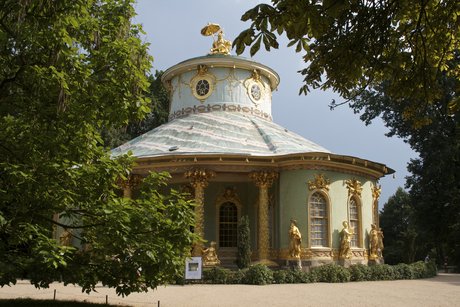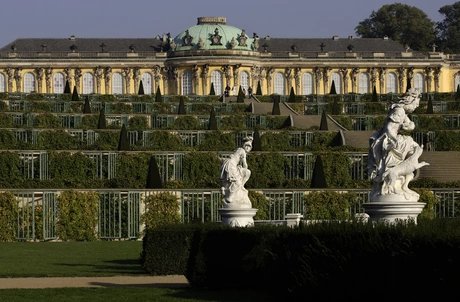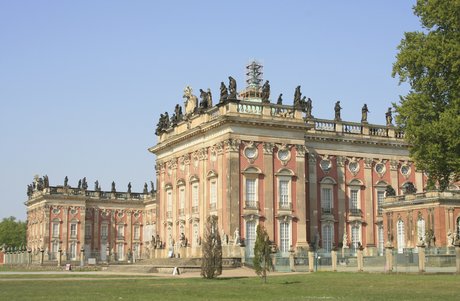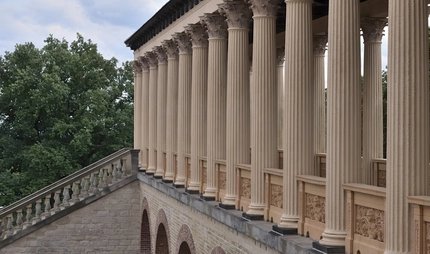
Sanssouci Palace
A royal summer retreat
Friedrich the Great built Sanssouci (literally ’without a care’) as a summer retreat – and the palace and spreading park are still magical places today.
Friedrich the Great was renowned for his modesty, epitomised in his saying “A crown is merely a hat that lets the rain in”. Without a show of pomp and circumstance, but with considerable personal discipline, he guided the fate of Prussia in the eighteenth century. His beloved summer palace was his ideal of everyone’s wish of living without a care – Sans souci.
On a small rise covered with vineyard terraces near Potsdam, Friedrich had his Sanssouci summer palace constructed in 1745 –1747. This was not merely a summer residence and his favourite place to stay. It also became a personal sanctuary, a place where he retreated in times of difficulties to relax in the company of his dogs. Friedrich was reluctant to have even minor repairs on the palace. Sanssouci was his private refuge and, as he said, “should only last my lifetime”.
Fortunately, though, his wish did not come true. Today, Sanssouci has lost none of its special magic and charm. The intimate suites of rooms still have their original elegant designs and furnishings. And the spreading park and grounds, with the stately Neues Palais (New Palace), the Neue Kammern (New Chambers), the Chinese House, Orangery, and the Charlottenhof Palace, are more impressive and beautiful than ever.
When he died, Friedrich wanted to be interred at Sanssouci Palace in a crypt on the uppermost terrace of the vineyard, close to where his much-loved greyhounds were buried. But it was many years before this wish was granted – not until his reburial there in 1991. Now, the “Philosopher of Sanssouci”, as he was popularly known, is at peace on the highest terrace of the hill.
Sanssouci Palace – History
In 1745, Friedrich II commissioned his architect Georg Wenzeslaus von Knobelsdorff to build him a small summer palace. Finished just two years later, it was set above a terraced vineyard with trellises and glazed niches, all laid out at the same time. There are also two other buildings to the right and left of the palace: the Neue Kammern (New Chambers), which Friedrich had constructed as a guest house, and the Picture Gallery with works by Rubens, Caravaggio and Tintoretto.
Later, Friedrich Wilhelm IV had the two wings enlarged. In 1873, Wilhelm I opened the palace as a museum – as one of the very first palace museums in Germany. Sanssouci survived the Second World War unscathed, though some of the art works and furniture removed for safe keeping went missing.
The palace is elegant rather than opulent – after all, it was intended as a summer residence, a retreat to enjoy the country air. In contrast to the baroque splendour of the stately Neues Palais (New Palace) at the other end of the park, Sanssouci is informed by the lighter spirit of the rococo. And with this little palace only comprising twelve rooms, it was clearly designed for intimacy rather than show.
The entire complex with its palaces and park is inscribed as UNESCO World Heritage, recognised as “an outstanding example of architectural creations and landscaping” and “a cultural property of exceptional quality”.
A question of perspective
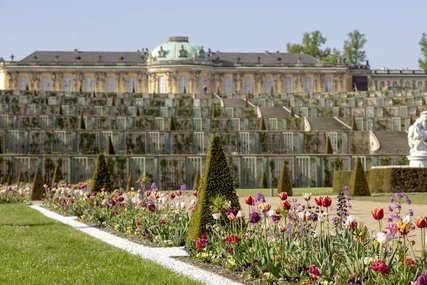
As you approach Sanssouci Palace from the park, you will notice that no matter where you stand, you cannot see all of Sanssouci at once. Knobelsdorff, Friedrich’s architect, would have liked the palace to stand out from below – as a classic sovereign display of power. But Friedrich was more interested in direct access to the terrace, and a feeling of living close to nature.
Sanssouci Park
The garden at the base of the terraces is baroque in style, with a large, central fountain. In the nineteenth century, Peter Joseph Lenné, Prussia’s leading landscape gardener, was commissioned to lay out the spreading park grounds. The park has many delightful decorative features, including the Neptune Grotto by Knobelsdorff, the small round neo-classical Temple of Friendship, which Friedrich built in memory of his favourite sister, and the Great Fountain. The Chinese House is a wonderful mix of rococo and chinoiserie, complete with three gilded figures. The interesting features nearby include the Historic Mill, set close to the Sanssouci Palace and grounds. For a stunning view of the area, it is well worth visiting the Norman Tower on the Ruinenberg hill and the two Belvederes – the Belvedere on Klausberg hill and the Belvedere on Pfingstberg hill.
The Orangery Palace, built in an Italianate style by Wilhelm IV, renowned as the “Romantic on the throne”, was the last building constructed in the park. Here, the sensitive plants in tubs spend winter in the plant halls. The main palace hall is naturally more ornate, and decorated by copies of Raphael’s works. The taste for an Italianate architectural style is also evident in the Roman Baths and the Friedenskirche (Church of Peace). The former royal Charlottenhof Palace with its gardens, designed jointly by architect Karl Friedrich Schinkel and landscape designer Peter Joseph Lenné, offers a fascinating mix of architecture and landscaping.
Unfortunately, the Orangery Palace and Charlottenhof Palace are currently not accessible due to renovation work.
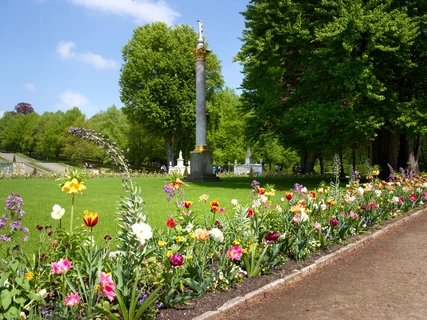
Potsdam – Night of the Palaces
Once a year in summer, the park is transformed into a vast stage for events. The sounds of classical music and jazz melodies echo through the nightime park, and the event closes with a spectacular firework display, lighting up the night.
Tickets for Sanssouci Palace
With the sanssouci+ tickets, available in all Berlin Tourist Infos, you can visit a wide selection of Prussian palaces and parks, including Sanssouci in Potsdam (except Sacrow Palace and Jagdschloss Stern in Potsdam; except the special exhibitions; reduced admission to the Belvedere on Pfingstberg).
Here a small insight into the Sanssouci Park.
We would be delighted if you could give us some brief, anonymous feedback on your visit to Sanssouci Palace! Please take a few moments of your time.
Opening hours
| Tuesday | |
|---|---|
| Wednesday | |
| Thursday | |
| Friday | |
| Saturday | |
| Sunday |



